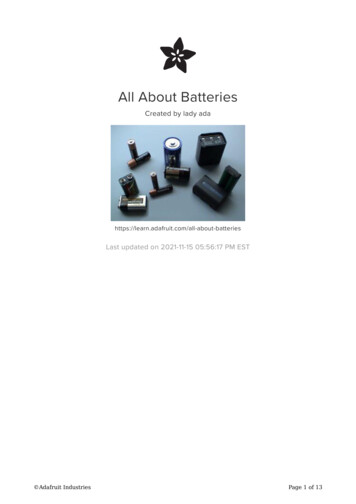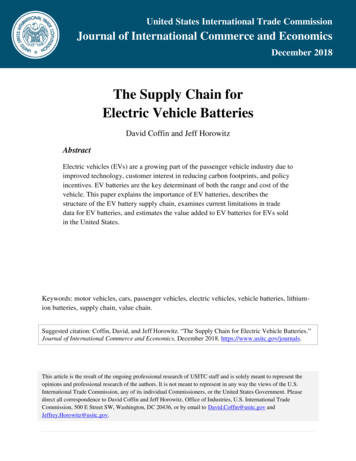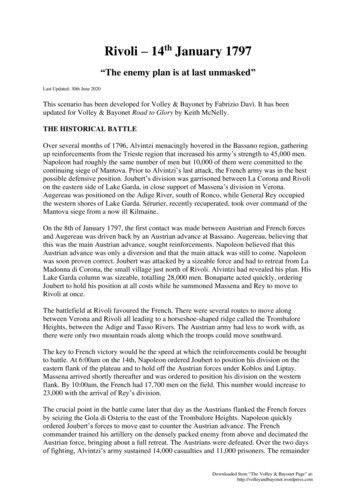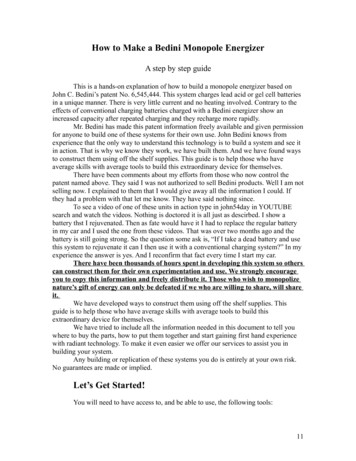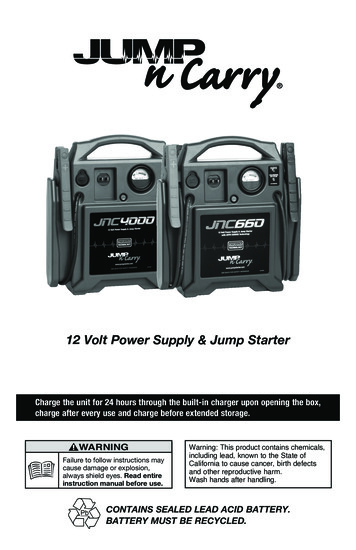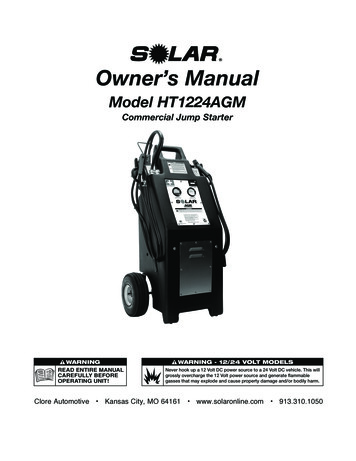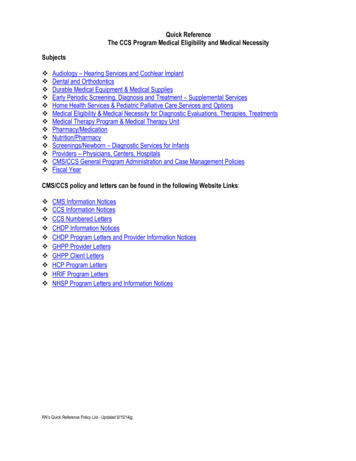
Transcription
10BatteriesDavid G. VutetakisDouglas Battery Co.10.1 Introduction10.2 General PrinciplesBattery Fundamentals10.3 Lead-Acid BatteriesTheory of Operation Cell Construction Battery Construction Discharge Performance Charge Methods TemperatureEffects and Limitations Service Life Storage Characteristics Maintenance Requirements Failure Modesand Fault Detection Disposal10.4 Nickel-Cadmium BatteriesTheory of Operation Cell Construction Battery Construction Discharge Performance Charge Methods TemperatureEffects and Limitations Service Life Storage Characteristics Maintenance requirements Failure Modes and FaultDetection Disposal10.5 ApplicationsCommercial Aircraft Military AircraftDefining TermsReferencesFurther Information10.1 IntroductionThe battery is an essential component of almost all aircraft electrical systems. Batteries are used to startengines and auxiliary power units, to provide emergency backup power for essential avionics equipment,to assure no-break power for navigation units and fly-by-wire computers, and to provide ground powercapability for maintenance and preflight checkouts. Many of these functions are mission critical, so theperformance and reliability of an aircraft battery is of considerable importance. Other important requirements include environmental ruggedness, a wide operating temperature range, ease of maintenance, rapidrecharge capability, and tolerance to abuse.Historically, only a few types of batteries have been found to be suitable for aircraft applications. Untilthe 1950s, vented lead-acid (VLA) batteries were used exclusively [Earwicker, 1956]. In the late 1950s,military aircraft began converting to vented nickel-cadmium (VNC) batteries, primarily because of theirsuperior performance at low temperature. The VNC battery subsequently found widespread use in bothmilitary and commercial aircraft [Fleischer, 1956; Falk and Salkind, 1969]. The only other type of batteryused during this era was the vented silver-zinc battery, which provided an energy density about threetimes higher than VLA and VNC batteries [Miller and Schiffer, 1971]. This battery type was applied toseveral types of U.S. Air Force fighters (F-84, F-105, and F-106) and U.S. Navy helicopters (H-2, H-13,and H-43) in the 1950s and 1960s. Although silver-zinc aircraft batteries were attractive for reducingweight and size, their use has been discontinued due to poor reliability and high cost of ownership. 2001 by CRC Press LLC
In the late 1960s and early 1970s, an extensive development program was conducted by the U.S. AirForce and Gulton Industries to qualify sealed nickel-cadmium (SNC) aircraft batteries for military andcommercial applications [McWhorter and Bishop, 1972]. This battery technology was successfully demonstrated on a Boeing KC-135, a Boeing 727, and a UH-1F helicopter. Before the technology could betransitioned into production, however, Gulton Industries was taken over by SAFT and a decision wasmade to terminate the program.In the late 1970s and early 1980s, the U.S. Navy pioneered the development of sealed lead-acid (SLA)batteries for aircraft applications [Senderak and Goodman, 1981]. SLA batteries were initially applied tothe AV-8B and F/A-18, resulting in a significant reliability and maintainability (R&M) improvementcompared with VLA and VNC batteries. The Navy subsequently converted the C-130, H-46, and P-3 toSLA batteries. The U.S. Air Force followed the Navy’s lead, converting numerous aircraft to SLA batteries,including the A-7, B-1B, C-130, C-141, KC-135, F-4, and F-117 [Vutetakis, 1994]. The term “HighReliability, Maintenance-Free Battery,”or HRMFB, was coined to emphasize the improved R&M capabilityof sealed-cell aircraft batteries. The use of HRMFBs soon spun off into the commercial sector, andnumerous commercial and general aviation aircraft today have been retrofitted with SLA batteries.In the mid-1980s, spurred by increasing demands for HRMFB technology, a renewed interest in SNCbatteries took place. A program to develop advanced SNC batteries was initiated by the U.S. Air Force,and Eagle-Picher Industries was contracted for this effort [Flake, 1988; Johnson et al., 1994]. The B-52bomber was the first aircraft to retrofit this technology. SNC batteries also have been developed by ACMEfor several aircraft applications, including the F-16 fighter, Apache AH-64 helicopter, MD-90, and Boeing777 [Anderman, 1994].A recent development in aircraft batteries is the “low maintenance”or “ultra-low maintenance”nickelcadmium battery [Scardaville and Newman, 1993]. This battery is intended to be a direct replacementof conventional VNC batteries, avoiding the need to replace or modify the charging system. Althoughthe battery still requires scheduled maintenance for electrolyte filling, the maintenance frequency can bedecreased significantly. This type of battery has been under development by SAFT and more recently byMarathon. Limited flight tests have been performed by the U.S. Navy on the H-1 helicopter. Applicationof this technology to commercial aircraft is also being pursued.Determining the most suitable battery type and size for a given aircraft type requires detailed knowledgeof the application requirements (load profile, duty cycle, environmental factors, and physical constraints)and the characteristics of available batteries (performance capabilities, charging requirements, life expectancy, and cost of ownership). With the various battery types available today, considerable expertise isrequired to size, select, and prepare technical specifications. The information contained in this chapterwill provide general guidance for original equipment design and for upgrading existing aircraft batteries.More detailed information can be found in the sources listed at the end of the chapter.10.2 General Principles10.2.1 Battery FundamentalsBatteries operate by converting chemical energy into electrical energy through electrochemical dischargereactions. Batteries are composed of one or more cells, each containing a positive electrode, negativeelectrode, separator, and electrolyte. Cells can be divided into two major classes: primary and secondary.Primary cells are not rechargeable and must be replaced once the reactants are depleted. Secondary cellsare rechargeable and require a DC charging source to restore reactants to their fully charged state.Examples of primary cells include carbon-zinc (Leclanche or dry cell), alkaline-manganese, mercuryzinc, silver-zinc, and lithium cells (e.g., lithium-manganese dioxide, lithium-sulfur dioxide, and lithiumthionyl chloride). Examples of secondary cells include lead-lead dioxide (lead-acid), nickel-cadmium,nickel-iron, nickel-hydrogen, nickel-metal hydride, silver-zinc, silver-cadmium, and lithium-ion. Foraircraft applications, secondary cells are the most prominent, but primary cells are sometimes used forpowering critical avionics equipment (e.g., flight data recorders). 2001 by CRC Press LLC
Batteries are rated in terms of their nominal voltage and ampere-hour capacity. The voltage ratingis based on the number of cells connected in series and the nominal voltage of each cell (2.0 V for leadacid and 1.2 V for nickel-cadmium). The most common voltage rating for aircraft batteries is 24 V. A24-V lead-acid battery contains 12 cells, while a 24-V nickel-cadmium battery contains either 19 or 20 cells(the U.S. military rates 19-cell batteries at 24 V). Voltage ratings of 22.8, 25.2, and 26.4 V are also commonwith nickel-cadmium batteries, consisting of 19, 20, or 22 cells, respectively. Twelve-volt lead-acid batteries, consisting of six cells in series, are also used in many general aviation aircraft.The ampere-hour (Ah) capacity available from a fully charged battery depends on its temperature,rate of discharge, and age. Normally, aircraft batteries are rated at room temperature (25 C), the C-rate(1-hour rate), and beginning of life. Military batteries, however, often are rated in terms of the end-oflife capacity, i.e., the minimum capacity before the battery is considered unserviceable. Capacity ratingsof aircraft batteries vary widely, generally ranging from 3 to 65 Ah.The maximum power available from a battery depends on its internal construction. High rate cells,for example, are designed specifically to have very low internal impedance as required for starting turbineengines and auxiliary power units (APUs). Unfortunately, no universally accepted standard exists fordefining the peak power capability of an aircraft battery. For lead-acid batteries, the peak power typicallyis defined in terms of the cold-cranking amperes, or CCA rating. For nickel-cadmium batteries, the peakpower rating typically is defined in terms of the current at maximum power, or Imp rating. These ratingsare based on different temperatures ( 18 C for CCA, 23 C for Imp), making it difficult to comparedifferent battery types. Furthermore, neither rating adequately characterizes the battery’s initial peakcurrent capability, which is especially important for engine start applications. More rigorous peak powerspecifications have been included in some military standards. For example, MIL-B-8565/15 specifies theinitial peak current, the current after 15 s, and the capacity after 60 s, during a 14-V constant voltagedischarge at two different temperatures (24 and 26 C).The state-of-charge of a battery is the percentage of its capacity available relative to the capacity whenit is fully charged. By this definition, a fully charged battery has a state-of-charge of 100% and a batterywith 20% of its capacity removed has a state-of-charge of 80%. The state-of-health of a battery is thepercentage of its capacity available when fully charged relative to its rated capacity. For example, a batteryrated at 30 Ah, but only capable of delivering 24 Ah when fully charged, will have a state-of-health of24/30 100 80%. Thus, the state-of-health takes into account the loss of capacity as the battery ages.10.3 Lead-Acid Batteries10.3.1 Theory of OperationThe chemical reactions that occur in a lead-acid battery are represented by the following equations: Positive electrode: PbO 2 H 2 SO 4 2H 2eNegative electrode: Pb H 2 SO 4 discharge---------------------chargeOverall cell reaction: PbO 2 pb 2H 2 SO 4discharge---------------------chargePbsO 4 2H 2 O PbSO 4 2H 2edischarge---------------------charge 2PbSO 4 2H 2 O(1)(2)(3)As the cell is charged, the sulfuric acid (H2SO4) concentration increases and becomes highest when thecell is fully charged. Likewise, when the cell is discharged, the acid concentration decreases and becomesmost dilute when the cell is fully discharged. The acid concentration generally is expressed in terms ofspecific gravity, which is weight of the electrolyte compared to the weight of an equal volume of pure water. 2001 by CRC Press LLC
The cell’s specific gravity can be estimated from its open circuit voltage using the following equation:Specific Gravity (SG) Open Circuit Voltage (OCV) 0.84(4)There are two basic cell types: vented and recombinant. Vented cells have a flooded electrolyte, andthe hydrogen and oxygen gases generated during charging are vented from the cell container. Recombinantcells have a starved or gelled electrolyte, and the oxygen generated from the positive electrode duringcharging diffuses to the negative electrode where it recombines to form water by the following reaction:Pb H 2 SO 4 1 2O 2 PbSO 4 H 2 O(5)The recombination reaction suppresses hydrogen evolution at the negative electrode, thereby allowingthe cell to be sealed. In practice, the recombination efficiency is not 100% and a resealable valve regulatesthe internal pressure at a relatively low value, generally below 10 psig. For this reason, sealed lead-acidcells are often called “valve-regulated lead-acid” (VRLA) cells.10.3.2 Cell ConstructionLead-acid cells are composed of alternating positive and negative plates, interleaved with single or multiplelayers of separator material. Plates are made by pasting active material onto a grid structure made of leador lead alloy. The electrolyte is a mixture of sulfuric acid and water. In flooded cells, the separator materialis porous rubber, cellulose fiber, or microporous plastic. In recombinant cells with starved electrolytetechnology, a glass fiber mat separator is used, sometimes with an added layer of microporous polypropylene. Gell cells, the other type of recombinant cell, are made by absorbing the electrolyte with silicagel that is layered between the electrodes and separators.10.3.3 Battery ConstructionLead-acid aircraft batteries are constructed using injection-molded, plastic monoblocs that contain agroup of cells connected in series. Monoblocs typically are made of polypropylene, but ABS is used byat least one manufacturer. Normally, the monobloc serves as the battery case, similar to a conventionalautomotive battery. For more robust designs, monoblocs are assembled into a separate outer containermade of steel, aluminum, or fiberglass-reinforced epoxy. Cases usually incorporate an electrical receptaclefor connecting to the external circuit with a quick connect/disconnect plug. Two generic styles of receptaclesare common: the “Elcon style” and the “Cannon style.” The Elcon style is equivalent to military typeMS3509. The Cannon style has no military equivalent, but is produced by Cannon and other connectormanufacturers. Batteries sometimes incorporate thermostatically controlled heaters to improve lowtemperature performance. The heater is powered by the aircraft’s AC or DC bus. Figure 10.1 shows anassembly drawing of a typical lead-acid aircraft battery; this particular example does not incorporate a heater.10.3.4 Discharge PerformanceBattery performance characteristics usually are described by plotting voltage, current, or power vs.discharge time, starting from a fully charged condition. Typical discharge perfo
Battery Fundamentals 10.3 Lead-Acid Batteries Theory of Operation Cell Construction Battery Construction Discharge Performance Charge Methods Temperature Effects and Limitations Service Life Storage Characteristics Maintenance Requirements Failure Modes and Fault Detection Disposal 10.4 Nickel-Cadmium Batteries Theory of Operation Cell Construction
